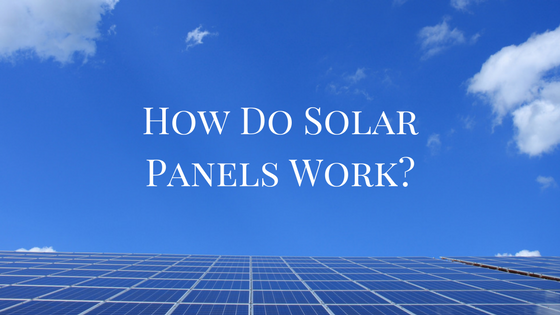Solar Power Blog

How Do Solar Panels Work?
How Solar Panels Work
In a bid to create energy sources that are sustainable and safe to use, scientists have continued to come up with different ways to efficiently extract useful energy from natural occurring sources. One of these forms of energy is solar energy. It’s main source being the sun, solar energy provides a renewable source of power that is clean and safe. To gain useful energy, the sun’s energy through radiation is captured and converted into electrical energy for domestic and industrial uses.
The sun produces photons that hit the earth in about 8 1/2 minutes. These photons can generate electricity when they hit the cells of a solar panel. A solar panel is a photo voltaic cell made of positive and negative silicon sides that together generate an electric field. PV solar panels form DC electricity which can be used to power various home electrical equipment. PV solar panels are easy to maintain and safe to use. They produce no greenhouse effect and no noise pollution. To be fit for use in homes and industries, this DC current must be converted to AC current. This can be done using an inverter.
The Inverter
Inverters come along with solar panel installations at home. They are usually located in an accessible location, mounted on top of one another near the electrical mains in a residential building. Inverters convert the DC current from the solar panel stored in batteries to AC current. The inverter and electricity meters are usually connected in a such a way that the energy produced by the solar system will be consumed first by by electrical appliances that are running.
Things to Consider when Installing Solar Panels
Knowing how the solar panel works, it is important to consider some necessary things that will ensure you derive maximum power from your solar panels
- Shade: Direct exposure to sunlight will produce the maximum amount of solar energy you require to power home and industrial appliances. Putting your solar panel under shade will limit the amount of power produced as there will not be enough contact with the sun. When installing the panels, it will be best to find the area of your roof that is not shaded by trees and other obstacles.
- Season: knowing that solar energy has to do with the sun’s intensity, hotter seasons will definitely produce more energy than winter and humid seasons. You will need to consider the season and have alternatives for when there won’t be as much sun.
- Angle: Solar panels are at their best when they are tilted at an angle. They should ideally be placed at the same angle of the platform on which they are mounted. Pitches of 30-45 are often used and work best.
- Azimuth Angle: Azimuth angle is the compass direction of the solar panel with respect to where the sun is radiating from. It is best to understand how the sun works at different times of the day, as a wrong azimuth angle can reduce efficiency of the solar panels by about 35%.
Applications of Solar Energy
Solar energy has become useful in a lot of ways. Through the use of solar panels, energy from the sun can be captured, stored and used to drive a lot gadgets and technological innovations.
- Transportation: New technology has innovated ways to use PV cells to power railroads, cars and subways. In China, solar buses exist that help to reduce emissions of carbon dioxide into the environment. In the world of car racing, solar cars have been launched to be used for competitions around the world.
- Lightning: Solar has been employed usefully to help with outdoor lightning. Solar panels mounted on street lights help to power the light bulbs through energy derived from the sun. Outdoor solar lights usually do not require complicated set ups. Outdoor solar lights are wireless and use the sunlight during the day to store up energy that can be used when the night falls. Apart from lighting up the environment, they provide a certain aesthetic appeal to the surrounding, acting as a form of decor. Solar lights are also relatively cheap to purchase.
- Powering Electronics: There are a couple of household appliances that can be powered by exposure to sunlight. Lamps that have solar panels attached to them exist. There are also solar air conditioners, dryers, radios and speakers. New technology has also found a way to use solar energy to power wristwatches! There is so much effort being put in place to maximally harness the possibilities of solar energy in place of fossil fuels which have presented harmful effects to the environment.
- Heaters: Solar energy can be converted into thermal energy for home heating. There are solar heaters available for home installation. For example solar space heaters convert energy from the sun into heat energy with the help of liquid or air. Solar water heaters also use water as a medium for this sane purpose.This technology can be used to heat pools and constitute one of the elements of a smart home.

